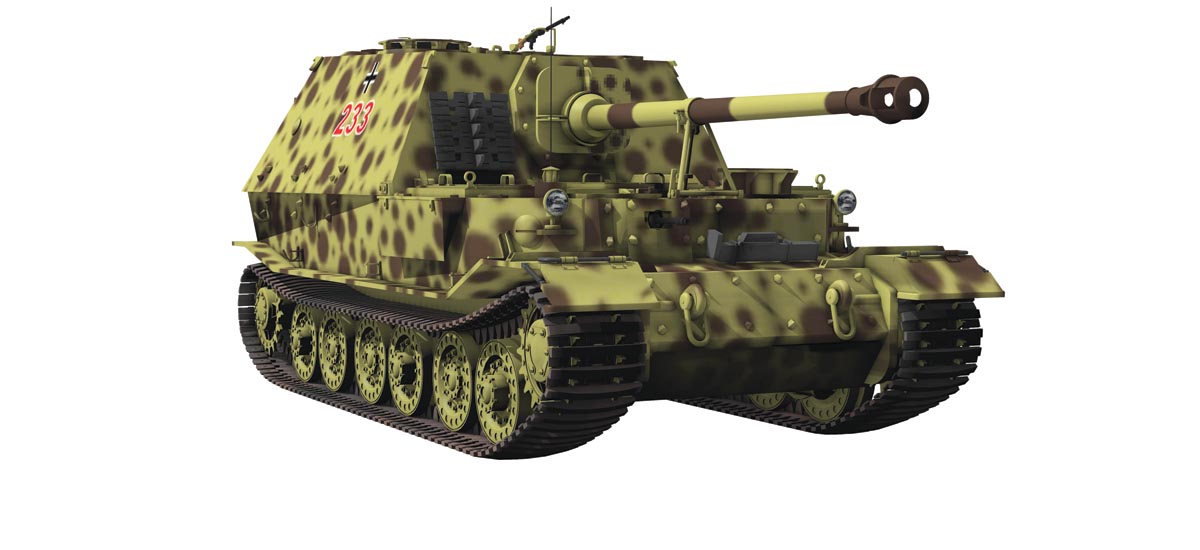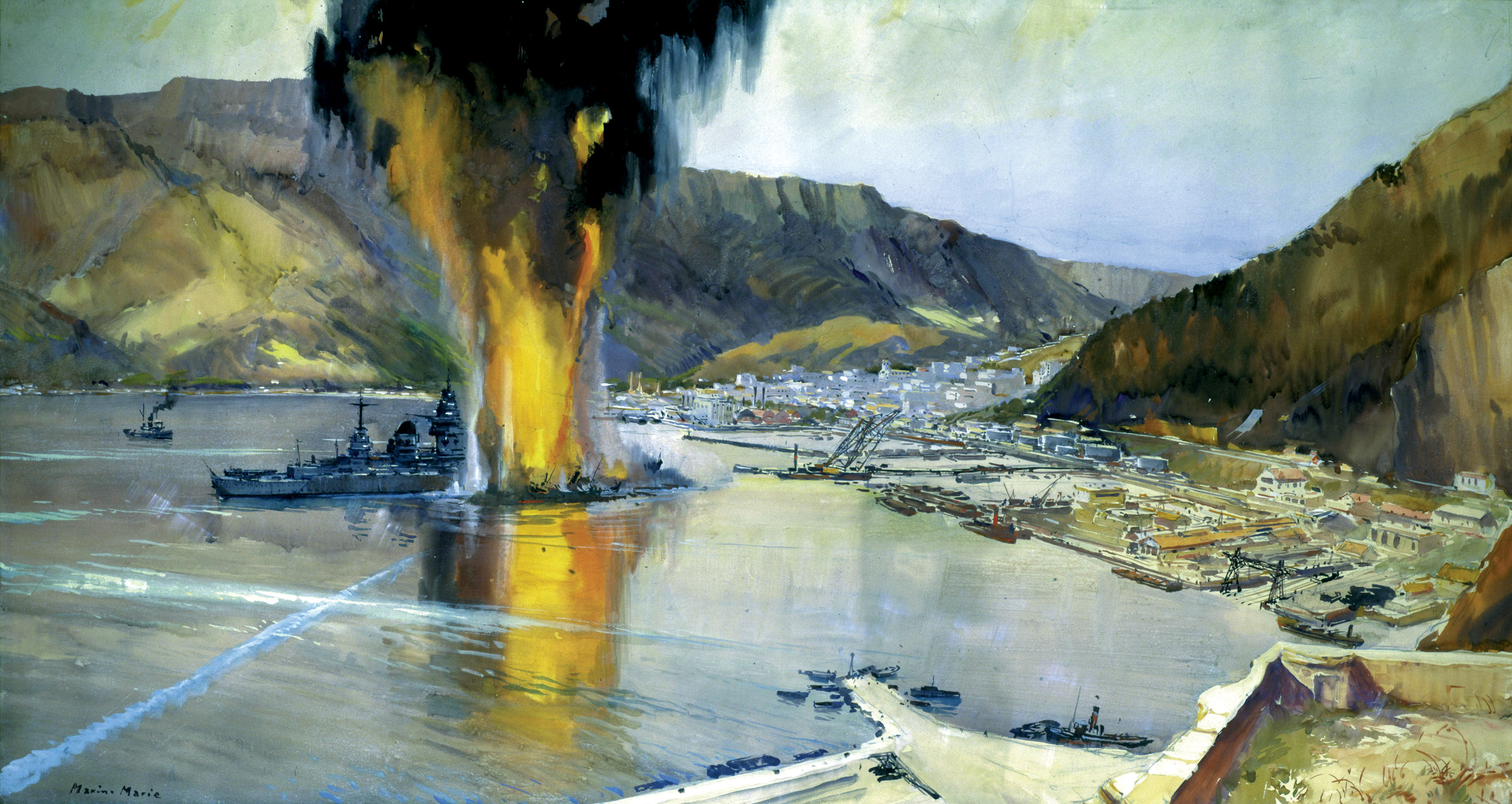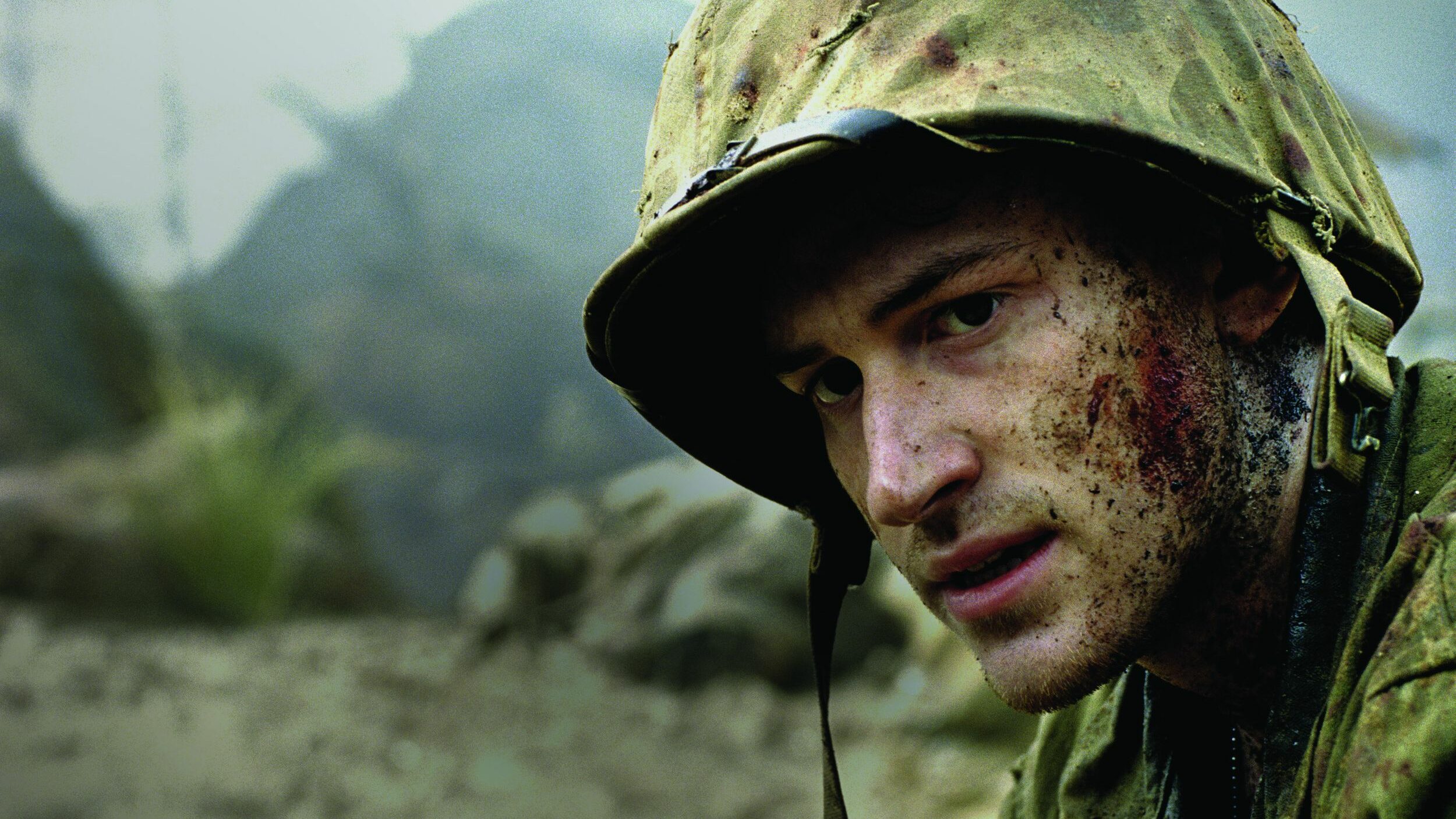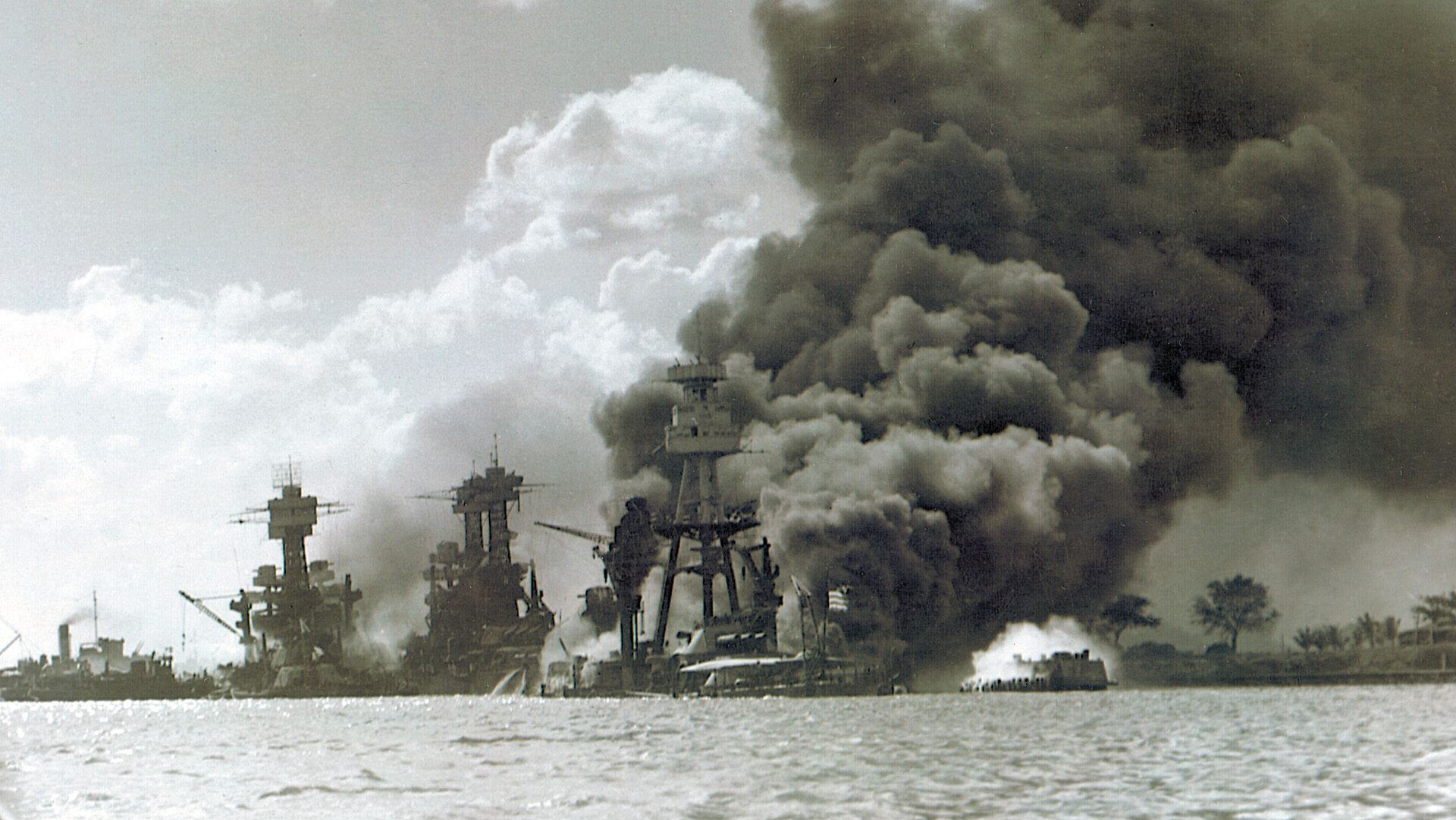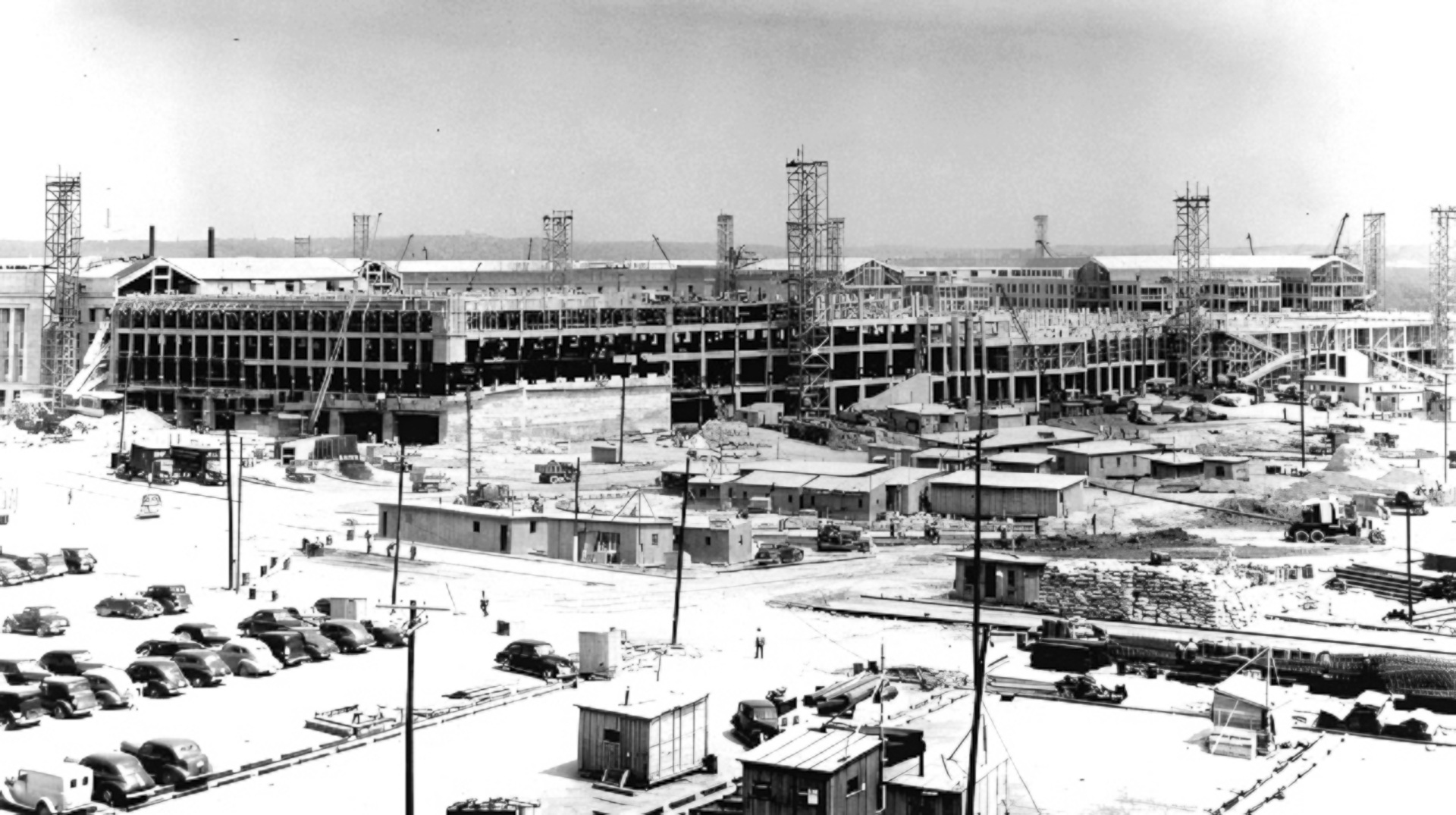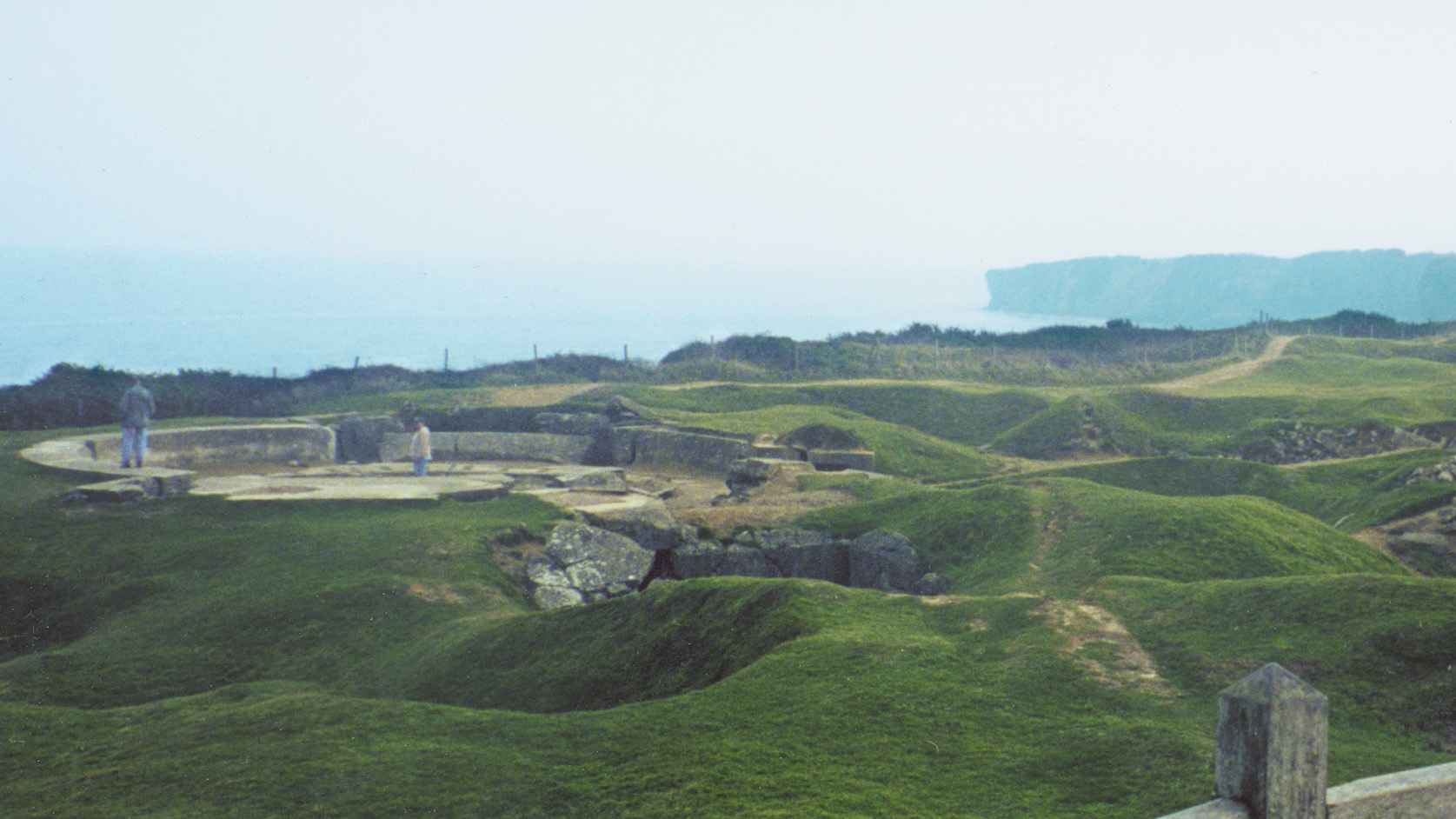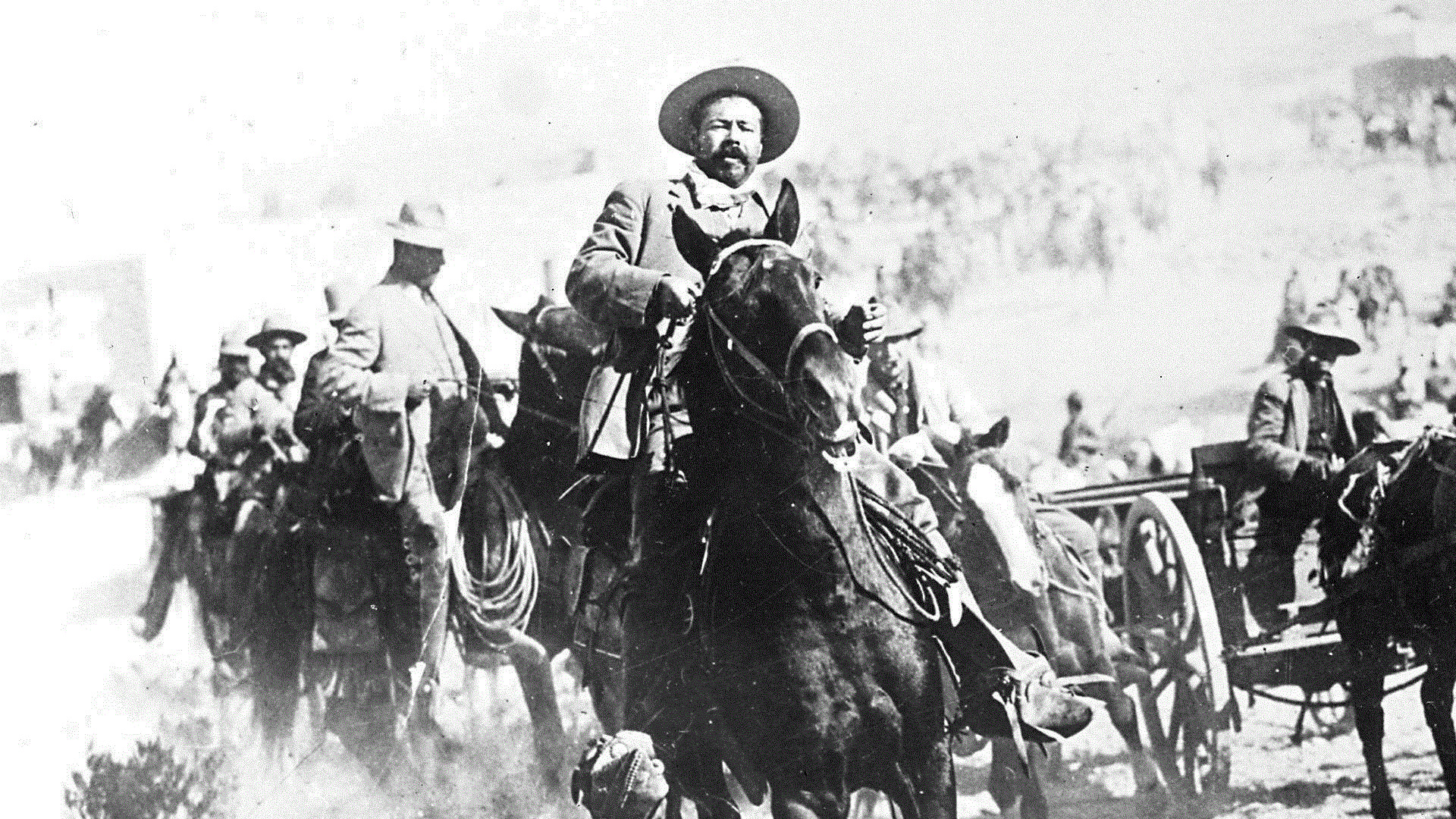By John E. Spindler
It is dusk on July 17, 1943. The Red Army has not only withstood Hitler’s Operation Citadel to eliminate the Kursk salient, but it has launched its own offensive. On Kursk’s Northern Front the Soviets continue to hammer at the exhausted left flank of the German Ninth Army from the direction of Maloarchangelsk. Hauptman Rolf Henning’s kampfgruppe stands in the path of this counterattack. Before the day is over the kampfgruppe has decisively smashed the attack, destroying 22 Soviet tanks, some at more than 2,500 meters. Henning was personally responsible for 10 of the kills, while Leutnant Hermann Feldheim tallied 11 more. Both were vehicle commanders in one of Hitler’s new wonder weapons at Kursk, the heavy tank destroyer (Jagdpanzer) Ferdinand. Named in honor of Ferdinand Porsche, the Ferdinand, which was later renamed the Elefant, had a decisive effect in any armored clash in which it participated.
The Ferdinand had its origins as Porsche’s failed entry into the heavy tank competition for what would eventually be the famous Tiger tank. Being a friend of German leader Adolf Hitler, his design was expected to win; however, test trials in 1942 showed the Porsche model failed in deep mud and its drive system was mechanically unreliable, thus the Henschel model was selected. Assuming his design would win, Porsche already had stored 100 Krupp-built hulls at the Nibelungenwerke in St. Valentin, Austria. He submitted a proposal to build a heavy tank destroyer using these hulls. The specifications for this turretless vehicle included a maximum frontal armor thickness of 200 mm and use of the 88mm Pak 43/2 antitank gun, the most powerful in Germany at the time. An order was issued in October 1942 for the conversion of 90 hulls into the new tank destroyer.
Porsche supervised the development of the vehicle. Layout began with the standard formula used in Germany. The design called for the driving compartment to be placed in the front, the fighting compartment in the middle, and two engines in the rear. To compensate for the recoil of its main gun, designers extended the back of the casement to the back of the hull. With the main gun now firmly placed toward the rear of the chassis, the engines were relocated into the middle of the vehicle.
Officially named the Ferdinand on February 6, 1943, the vehicle required a crew of six. The driver and radio operator were situated at the front of the vehicle. The vehicle’s commander, gunner, and two loaders were situated in the fighting compartment. As the main purpose of the vehicle was to destroy tanks, it boasted an 88mm Pak 43/2 L71 gun. Fixed racks allowed for 36 rounds of armor-piercing or high-explosive ammunition, although the vehicle could carry as many as 90 rounds when necessary. The gun was so powerful that it could penetrate the front armor of the Soviet IS-2 at 2,300 meters, which was well before the IS-2 could get into the range of 500 meters to fire a round that could penetrate the Ferdinand. Unfortunately, the German designers failed to install a secondary machine gun, and this turned out to be a major flaw during combat on the Eastern Front.
For survival in battle, the 100mm hull front armor was doubled by the addition of a 100mm bolted-on plate, making the Ferdinand practically impenetrable.
“Even the heavy Soviet Josef Stalin tank hit us many times on the frontal armor without any effect,” said Emanuel Schlenzka, a Ferdinand gun commander. Both the hull and superstructure sides had an armor thickness of 80mm, while the tops of both were 30mm and the hull bottom a mere 20mm thick.
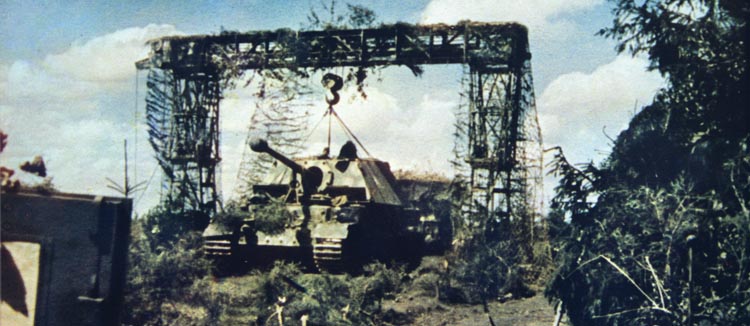
A pair of V-12 265-horsepower Maybach HL 120 petrol engines powered the Ferdinand. The arrangement of the two engines, fuel tanks, generator, and drive motors in such a confined space, though, frequently resulted in overheating from an inadequate air supply to the carburetors. This design flaw plagued the vehicle throughout its service.
The engines were extremely loud and could reportedly be heard up to five miles away. Supporting this armored giant, which had a combat weight near 69 tons, was a suspension system differing from the conventional German tank design as the Porsche design did not possess return rollers. The heaviest armor-fighting vehicle of the time when it went into battle, the Ferdinand was 26 feet, 8 inches long (with its gun), and slightly more than 11 feet wide, and 9 feet, 9 inches tall. Its sheer bulk adversely affected its speed and range. The heavy tank destroyer had a maximum speed of only 19 mph and a cross-country range of just 55 miles.
It took the Germans a relatively short time to build the initial 90 Ferdinands. Production began at the Nibelungenwerke plant on February 16, 1943. The last vehicle rolled out of the plant three months later. The Wehrmacht established two heavy tank destroyer battalions, each having 45 Ferdinands, on March 22. Designated as heavy tank destroyer battalions, they were numbered 653 and 654. Heavy Tank Destroyer Regiment 656 was established on June 8. The regiment combined the two battalions under the overall command of Obstl. Der Reserve Baron Ernst von Jungenfeld. The regiment also included a battalion that fielded the new Sturmpanzer IV. The battalions did not get any time to train together.
Heavy Tank Destroyer Regiment 656 began its trek eastward toward Orel on June 9. As part of Field Marshall Walter Model’s Ninth Army, the regiment was placed under the command of the XXXXI Panzer Corps. The various elements had arrived at the designated assembly point by July 1. Positioned on the far left wing, the Ferdinand’s combat debut was about to take place in Operation Citadel. For the initial push, both heavy Jagdpanzer battalions would go into action on level ground in support of the 86th Infantry Division. After penetrating enemy lines, Regiment 654 would switch its support to the 292nd Infantry Division, also of the XLI Panzer Corps. The Orel-Kursk railway was the boundary line; Regiment 653 would deploy east of the railway, and 654 would deploy west of the railway. Before combat began, six Ferdinands had to be withdrawn for repairs. It was a bad omen.
Operation Citadel began at 3:40 am on July 5. The first objective for Regiment 656 was Hill 257.7, the cornerstone of the Soviet defenses in the area. The combination of a powerful gun and impenetrable front armor proved a lethal combination as the Ferdinands overran the first of three Soviet defensive lines. Reports stated the regiment destroyed several antitank guns and 26 T-34 tanks; however, dozens of the Ferdinands succumbed to enemy mines.
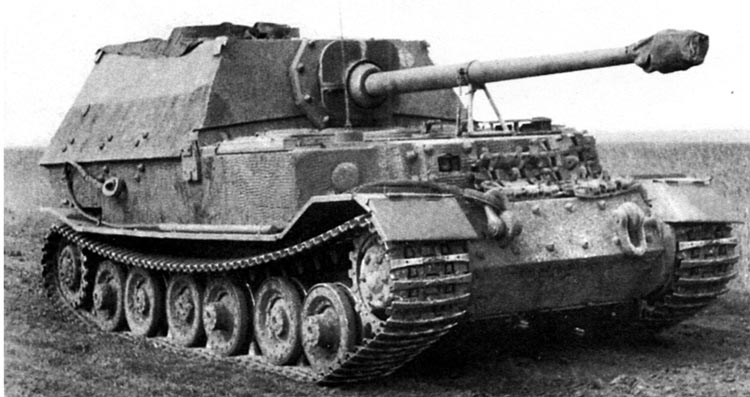
Although the Ferdinand was an unexpected surprise to Soviets, they soon learned that like any armored fighting vehicle, the tracks proved highly vulnerable to antitank fire. Being such large targets, the Ferdinands were a magnet for enemy artillery. Because of this, German infantrymen were reluctant to follow closely behind the heavy Jagdpanthers. This lack of infantry support was more of a factor than the lack of the hull machine gun. Postwar stories of Soviet crews knocking out Ferdinands with Molotov cocktails have been exaggerated. Despite the regiment having achieved all of its objectives—shattering the Red Army’s first line of defense and critically weakening its second—only 12 Ferdinands remained operational at the end of the day. Soviet mines and antitank fire had disabled the tracks and suspensions of the majority of the Ferdinands. Soviet artillery had completely destroyed two of the vehicles. Upon inspection, it turned out that the engine grating was not thick enough and the spacing was too wide, which allowed shrapnel to cripple the engines.
In the drive for the fortified village of Ponyri the following day, the Ferdinands engaged the SU-152 self-propelled heavy howitzer. Although not designed as a tank destroyer, the Soviets found it was the only vehicle capable of destroying the Panzerkampfwagen VI Tiger tank. Duels at up to 3,000 meters occurred, with one Ferdinand lost and several Su-152s knocked out. The Ferdinand’s high-velocity, 88mm cannon, which was supplemented by superior optics, overwhelmed the low-velocity, 152mm howitzers. For the next few days, Ferdinands continued to assist in the battles raging around the Ponyri rail station. Unfortunately, the number of combat-ready vehicles on any day was in the single digits. Though four vehicles were unsalvageable, damage from mines and mechanical issues kept almost all of the tank destroyers under repair.
The repair shops suffered from a chronic lack of spare parts. In addition, the Germans did not have a recovery vehicle capable of towing the heavy Ferdinand. It was only in June that three of the remaining hulls were converted to maintenance vehicles; however, these only had jib-boon cranes and no recovery equipment. Repair crews had 20 of the 40 vehicles back in action by July 11. Even in the small numbers available, the Ferdinands helped German forces overcome the second defensive line and part of the third line.
By July 11 the battle around Ponyri had severely exhausted German resources, taking a heavy toll of both men and equipment. Small numbers of Ferdinands were held back to deal with the growing number of Soviet tank-led attacks on the German flanks. One week into the offensive 19 Ferdinands had been listed as total losses. This included one abandoned vehicle captured by the Soviets. The situation abruptly changed on July 12 when the Soviets launched their own attack in the Orel salient. The Soviet attack initially was aimed at the Second Panzer Army, which was positioned north of the Ninth Army. Ten Ferdinands were part of the force sent north while the rest of Regiment 656 remained heavily engaged in combat in the Ponyri area. For the next few days, the Ferdinand proved without a doubt that it was well suited to defensive roles by knocking out a significant number of Soviet tanks. The Germans loaded most of the vehicles in the regiment onto railcars in Orel on July 20 in preparation for evacuating the untenable salient. The six vehicles that remained behind proved pivotal in stabilizing the area.
Ferdinand losses increased as Operation Citadel dragged on into August and the Germans continued their retreat. The Germans recorded 39 Ferdinands as total losses. They blew up many of the 20 Ferdinands that had been immobilized owing to mechanical failures and could not be recovered.
The lack of foresight to build a recovery vehicle capable of towing the 69-ton behemoth came back to haunt the Germans. As a late response, three of the remaining hulls were converted into a recovery vehicle known as the Bergepanzer Ferdinand. Unfortunately, the vehicle lacked a winch for pulling Ferdinands or other heavy armored fighting vehicles out of deep mud, which put a heavy strain on the recovery vehicle’s transmission. On August 6 Regiment 654 was ordered to deliver its remaining Ferdinands to its sister battalion before heading to France to be eventually equipped with the newly designed 45-ton Jagdpanther. On Hitler’s personal order the remaining Ferdinands were sent to a steelworks in Dnepropetrovsk to begin their long overdue repairs.
The overhaul of the vehicles turned out to be a long, drawn out process. Problems ranged from difficulty in obtaining sufficient transport to move the vehicle to the ever present lack of spare parts. The Germans ultimately fitted the Ferdinands with new tracks, engines, and other parts, but they made no design improvements despite a long list sent by Regiment 656. Needing all operational armored fighting vehicles at the front, the Germans sent groups of repaired Ferdinands to critical areas.
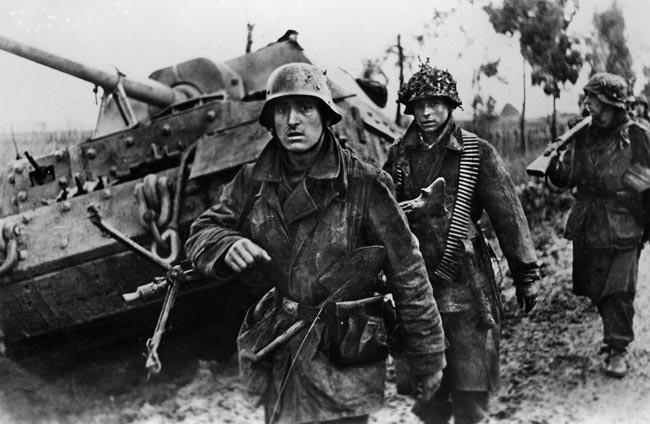
In late September the 40 Ferdinands in need of long-term repairs arrived in Nikopol, while 10 operational vehicles were deployed in the Zaporozhe bridgehead over the Dnieper River. Held as mobile reserve, the Ferdinands continued to be an invaluable asset, as demonstrated on October 10 when they repulsed a Soviet assault through the destruction of 48 enemy tanks. The number of kills continued at Krivoj Rog with another 21 tanks and 34 antitank guns eliminated. The regimental diary stated that from July 5 to November 5 the unit had destroyed 582 tanks, 344 antitank guns, 133 artillery pieces, three assault guns, 103 antitank rifles, and three aircraft. Although no records exist of exactly how many kills were attributed to the Ferdinand, there is little doubt it accounted for a very significant percentage. In December, orders came through for the Ferdinands to be sent to Nibelungenwerke in St. Valentin, Austria for repairs and modifications.
In January 1944 the much needed repair and improvement commenced. Among the key upgrades included the addition of a hull machine gun, the installation of a new commander cupola with seven vision blocks (this type of cupola was installed on the StuG III), replacement of the engine grating with a better designed one, and an additional 30mm armor plate attached to the bottom front hull section. Urgency to complete the overhaul arose on January 22, 1944, when the Allies landed at Anzio, threatening to outflank the German defensive lines south of Rome.
On February 15, the 1st Company of Regiment 653 received 11 Ferdinands, one Bergepanzer Ferdinand, and a maintenance platoon. The next day it was on its way to Italy. Arriving in the Anzio-Nettuno area a couple of weeks later, the company was attached to the LXXVI Panzer Corps. The Germans soon found the heavy vehicles unsuitable to the rolling terrain. The 69-ton vehicles also proved too heavy for Italy’s roads and bridges. In one instance, an Elefant fell through an old Roman bridge. Even before the company could engage the enemy, the Germans had to destroy two Ferdinands when one ran off the road and became pinned and the other struck a mine.
The Germans renamed the Ferdinand the Elefant in May. When the Allies finally broke out of the Anzio beachhead, the nine remaining Elefants were positioned along the Via Appia covering the approaches to Rome. The 1st Company of Regiment 653 knocked out several Allied tanks over a period of several days, but vehicle losses were high due to Allied air superiority. Allied fighter bombers destroyed two Elefants, and the Germans blew up others that became too damaged to salvage. The Americans took possession of an abandoned Elefant during this time. By June 21, only three Elefants and the Bergepanzer Elefant remained in service. Throughout the summer of 1944, the company withdrew to the north, reaching the city of Piadena on August 2 where it was loaded on railcars and sent to Vienna for repairs.
While the 1st Company of Regiment 653 was in combat in Italy, the Wehrmacht restocked the remaining two companies. The company, which had 31 Ferdinands, two Bergepanzer Elefants, and supporting vehicles, was sent to Brzezany, Poland, on April 2, 1944. Attached to SS-Obergruppenführer Wilhelm Bittrich’s 9th SS Panzer Division on April 6, the regiment was to assist in the relief of an encircled Tarnopol. Several vehicles suffered overheated engines while trying to negotiate the extremely muddy conditions. Lessons from the previous year were not learned as an insufficient supply of critical spare parts plagued repair efforts. The vehicles proved their worth fending off Soviet attacks along the Strypa River in late April, despite only having a low number of Ferdinands battle ready on any given day. The weight of their firepower compelled Soviet commanders to withdraw their armor; instead, the Soviets used large numbers of antitank guns and artillery pieces.
The battlefront remained relatively quiet in May, which allowed the Germans to conduct repairs. All but three Elefants were ready for action by June. The final four repaired vehicles joined the regiment, bringing it up to 28 vehicles. The calm was shattered on July 13 as part of the continuing Soviet offensive against Army Group Center. Regiment 653 fought a rearguard action at Pomorzony. The unit was still east of Lwow when the Soviets entered the city on July 22. The Germans withdrew their 12 remaining Elefants five days later. As with previous actions, the majority of lost Elefants resulted from their crews demolishing them after they became immobilized.
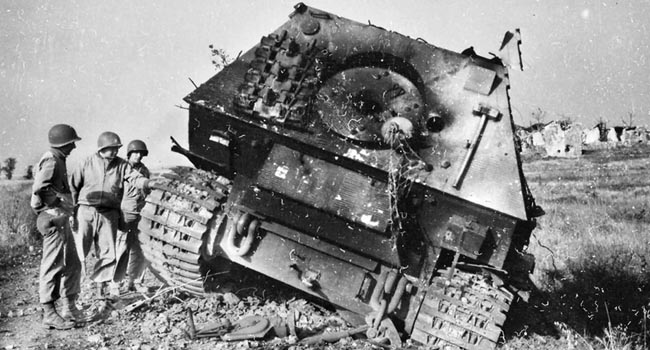
Shortly after extracting itself from the precarious situation, the regiment received orders to undergo repairs in Krakow, Poland. Two of the 1st Company’s surviving vehicles joined the unit, raising the total to 14 vehicles. The Germans consolidated the Elefants into a single Elefant company. At the end of July, the company was assigned to General der Infanterie Friedrich Schulz’s 17th Army. The other two companies fielded Jagdtigers.
The Elefant company remained in the Krakow-Tarnow area for a few months. On December 15, it was redesignated Heavy Tank Destroyer Company 614 and sent to the Kielce area under the command of the 4th Panzer Army. The Red Army launched another offensive along the Wisla-Odra Rivers in Poland on January 12, 1945. By month’s end the company had retreated all the way to Sorau. Only four Elefants survived, all of which needed repairs. A month later Company 614 was situated at Wunsdorf south of Berlin with its four Elefants ready once again for combat.
Assigned to Kampfgruppe Ritter, the unit fought near Zossen on April 22. Two more machines were abandoned due to unrepairable mechanical damage. The last two Elefants fought in the Battle of Berlin that began on April 16. One vehicle fought in Karl-August Square and the other at the Trinity Church. The Soviets eventually captured both vehicles.
Limited by poor mobility and being underpowered, the Ferdinand-Elefant was plagued by mechanical issues throughout its career; however, the heavy tank destroyer may have been the most successful employed given that it had an estimated kill ratio of 10 kills to every one vehicle lost. Because of this, the Ferdinand-Elefant had a significant influence on the outcome of most armored clashes in which it was engaged.
